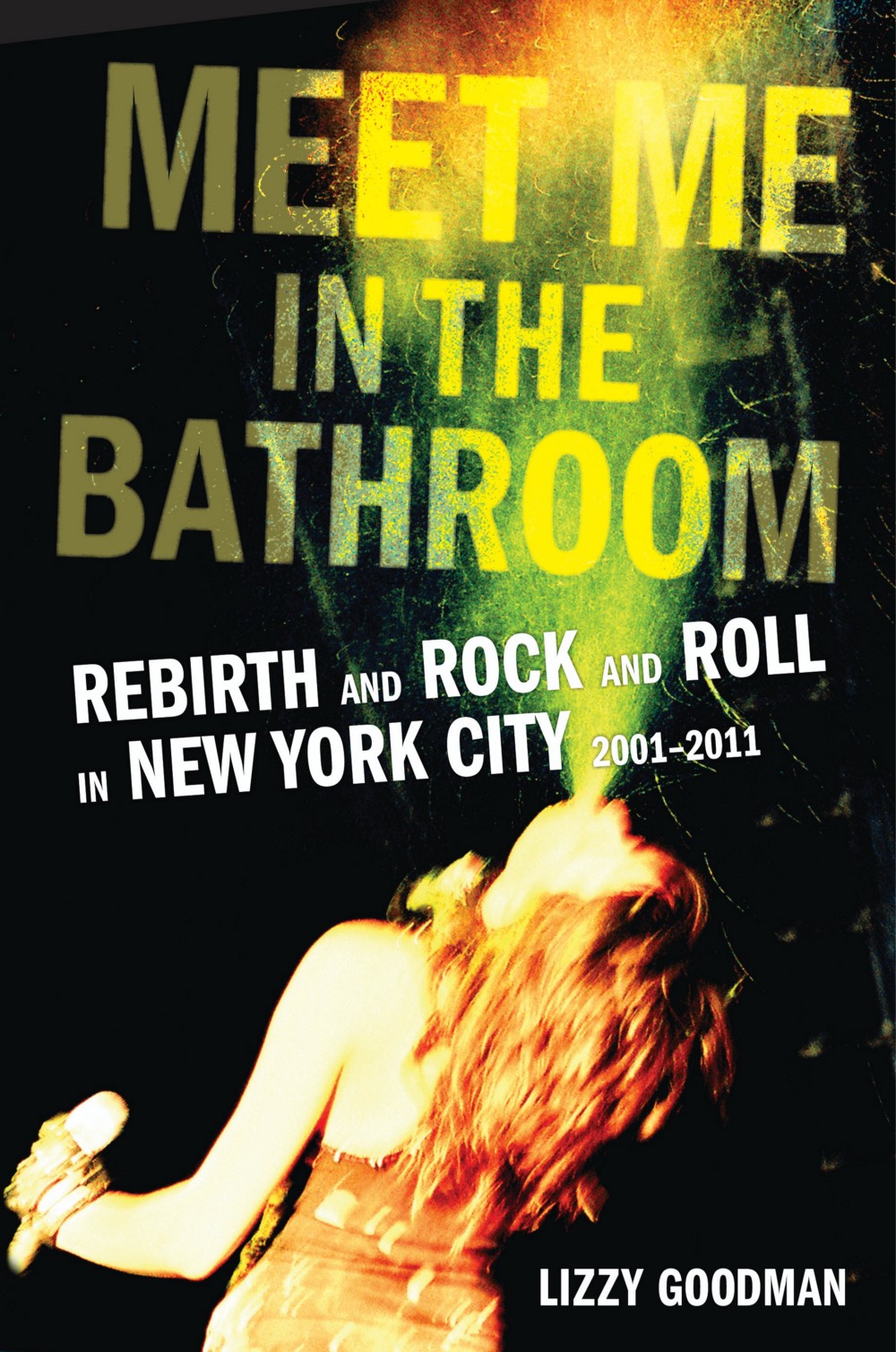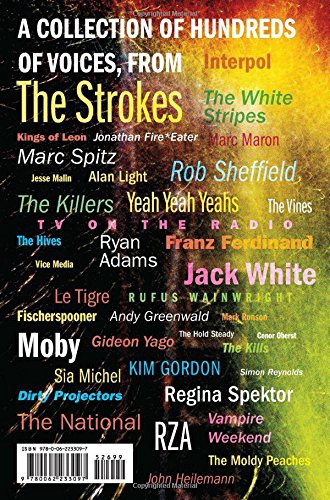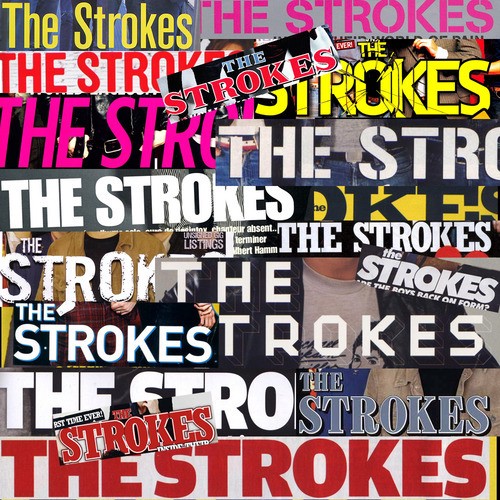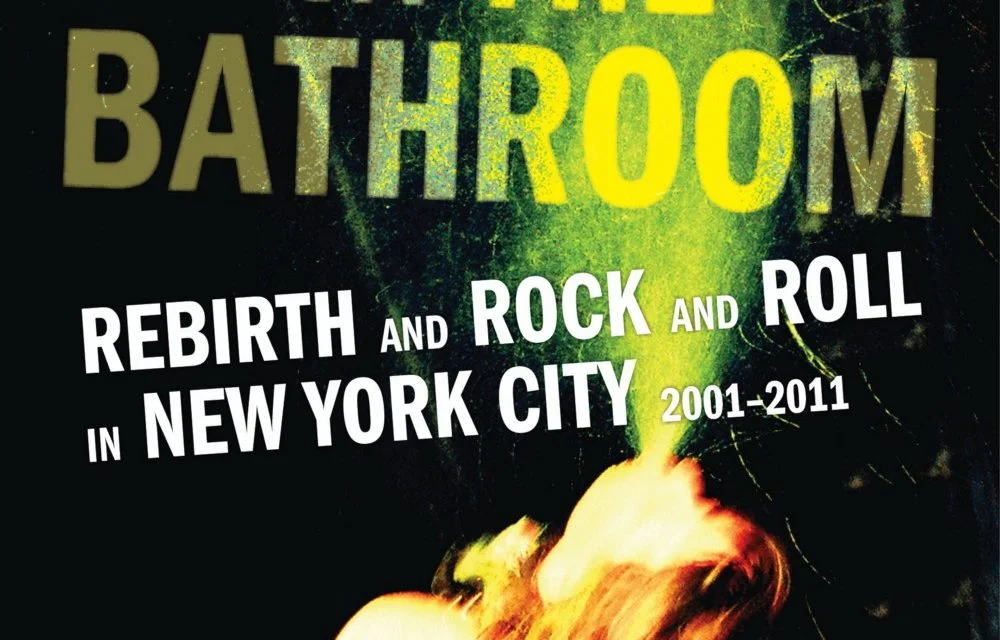Feeling over thought, with author: Lizzy Goodman

“I subscribe to the theory of writing to understand what you think.”
How do you capture the emotion of an 11-year artistic wave in New York City? Furthermore, how do you properly lay it out for the world to read in a way where it stays true to the intended form?
Well, at a glance you:
Carefully craft the pitch over the course of a year, go on a yoga retreat, conduct over 200 interviews, travel to numerous states, foreign countries, venues, apartments, parks, coffee shops, bars or restaurants, hold countless phone calls, turn your apartment walls into a canvas of shuffling names, take on other jobs simultaneously, and work feverishly for five years to not only use all the colors on New York’s pallet, but invent colors of your own to truly compliment the vibe.
Lizzy Goodman’s book, Meet Me In the Bathroom, is a great representation of the power of music — in its purest of forms. It’s 621 pages of oral history that details what transformed and transpired in New York City’s Rock n’ Roll scene that saw bands like The Strokes and Vampire Weekend take-off. Goodman brings you inside the connecting “moments” that made it so unique by subtley injecting her own passion of what it meant to her to be within the movement. Through all the challenges and anxieties that come with such an undertaking, Goodman stuck to one simple theme that ultimately played a crucial role in the book’s cultural flexibility — feeling over thought.
I recently had the chance to speak with Goodman about her creative process of bringing such feelings to life.

Can you take me inside the moment where you realized this subject matter was going to be a book you would pursue writing?
The week of the Strokes and LCD Soundstystem Madison Square Garden shows was the genesis, but it wasn’t like I woke up the next morning and thought, “Yes, it’s an oral history.” It was more the sensation of being there for both of those shows planted a seed of awareness of that period. What to do about that awareness and the process of figuring out what to do with it, was a long one. Where it started was realizing there was a story to be told and then trying to figure out a way to reverse-engineer tell it. That’s how all my stories start — with a sense of instinct that there’s something here that is making my radar go up, and what is that? I subscribe to the theory of writing to understand what you think. I started trying to figure out why I thought those shows and seeing those bands back-to-back made me feel like something had shifted. It felt like the end of one part of an era and into something else. Something like — establishment rock star status for those guys, and the beginning of actual adulthood for the rest of us. Allowing other people access to that time was the goal.
From that point, as a writer, where do you begin? Is it drawing up an outline of the story you want to tell in conjunction with identifying who you want to interview?
The next step was trying to figure out what form the story should take. I had never written an oral history before. I briefly thought about doing a collection of essays and works that I had done about the bands involved. That just felt gross, promotional and would fail to achieve the goal that I had — which was to return that notion of feeling, and sensing that something had ended that was valuable. I felt privileged to be able to have witnessed it. I wanted to create a sensory reading experience that would prioritize feeling over thought. That’s how that entire period felt. There wasn’t a lot of thinking involved. It was more feeling. To actually succeed in documenting that time, you needed a form that wasn’t so grainy as a collection of essays or me the rock person, trying to tell you what to think about The Strokes.
I struggled for awhile. It took me a full year to write the proposal and then five years to write the book. The proposal was finally written when I realized that oral history was the solution to all my problems. It’s designed to create the inherent contradictions that allow for exactly the immersive reading experience I was aiming for — how it felt to be there vs. what actually happened. When these memories are read together, it brings you much closer to the truth.
Once you reached “go time” what was the first thing you did? The first pen-to-paper?
The first thing you do is you are in total denial that you sold the book. For me, it was write the proposal for a year and sell the book. The shows were in the spring of 2011 and I sold the book in the spring of 2012. Then I went to a yoga teacher training. I’m a yoga nerd and always wanted to do a teacher training. It was a great feeling. I sold a publisher and I proved to myself that I could do this, so the first thing I was going to do was not work on it. It was a creative procrastination that I thought was very important. I exhaled.
Then, by the beginning of the summer, I went to my friend Ryan Gentles, The Strokes manager, and I told him I needed to talk. I went to his apartment, we had a couple of drinks, sat out in his courtyard area with these incredible New York vibes and I told him, “I am going to write a book about this time. Will you help me? Do I have your support?” I knew as a journalist that getting Ryan on-board and getting The Strokes part of the story was going to be crucial. Similarly, talking to my friend Imran Ahmed, who is also in the book, he’s an A&R head in the UK that signed Vampire Weekend, was an important step. With an oral history, its theoretical. To prove that it’s worth their time was an imperative step to have these guys in my corner.

In regards to individual artists, were there any that you marked as necessary to have involved in order for the book to work?
Yes, I knew I had to have Julian Casablancas, Jack White, Karen O and James Murphy. Those were the targets on the dartboard. Even though Jack White is not a New Yorker, this was about New York City as an idea, culturally. So there were people whose lives integrated with this idea, which was almost a stand-in for American cool. There’s no story without those guys. Interpol was next on the list. I had interviewed them a lot so I was comfortable with getting them involved.
What was your interview process like? How did you craft what you wanted to ask?
I set up all the interviews myself and I did every single interview myself. I transcribed probably half of them. I was out of my mind. Ryan or Imran and a few others were incredibly generous in making introductions for me. There was a lot of support from players large and small in terms of sending emails to the right managers and vouching for me. Jen Appel from Grandstand Media for example, went out of her way to help get The Killers in the book, and they are not a New York band. It’s important to say out loud, how many people served this and believed it could be a record of our time. Doors were opened for me without knowing if I would even finish it.
In terms of what happened after I’d get someone to agree to an interview; the process was different depending upon the person and the time I was interviewing them within the overall process. Three out of the five years it took to write the book was research. Basically interviews, research for the interviews, conducting and transcribing them. I’d use the transcripts to organize the events. I had what I called a “stalker wall.” I had all these poster boards on the wall of my apartment, and they were filled with names. It looked like I was a serial killer. Everything was color-coded and messy. I would do these interviews and then rearrange the priority list on the board.
The last two years, I tried not to do any interviews. The focus at the beginning was to cast wide nets. I would ask everybody about 9–11, about the first album they downloaded and their relationship with New York City was the first question I’d ask. Everything then would be a regular interview. I’d let people talk about the era and then drill down a little more on something they’d bring up. The goal over the last two years became — no more wide net. I’d have a version of my story and I’d have to keep things tight. It was a constant struggle because I had so many interesting things coming my way. You have to be really disciplined to not let new information boss you around, while on the other hand you have to be open to changing your story. It turned me into a crazy person.
I considered the book to have 10–20 primary characters. I would constantly be following their stories.
Where did your interviews take place?
All over the place. I would travel when needed. I went to London for three weeks and then came back, two different times. I really wanted to get that part of the story. There is a whole other book that could represent the London side. It was necessary to go to some of the places like Trash or the Columbia Hotel, that were important to these bands. Carl Barat took me walking around his neighborhood green on a rainy day and he bought me a bacon sandwich. That was our interview. The visceral nature of the reporting can really impact how things come out.
There was also a lot of meeting people in bars, coffee shops, talking over the phone, going to people’s shows and taking advantage of whenever somebody had 20 minutes or two hours.

Was there a time over the past few years where you worked exclusively on just this book?
Sadly, no. That would have been so nice. That was a challenge. It’s incredibly tough to balance the different things you are working on. It’s like the old switchboard from the 50’s and 60’s, where you’d see the phone operator taking plugs in and out to connect phones. That’s what my brain is like. I’m a pretty good multi-tasker, to have to be writing a story for New York Magazine or a Taylor Swift cover for Elle or a Kendrick Lamar piece for the New York Times, required a real discipline. I really cared about this other stuff too and needed to be writing about it. I was often balancing this, “Oh, I have to switch gears this afternoon to quickly get on the phone with David Holmes.” The rule I made for myself over time was don’t do both. Do a book day, do a feature day. But you can’t always do that. If someone is ready to talk to you on a certain day, you have to take it.
Was there ever a point throughout the process where you considered stopping the book? If so, how did you overcome that?
I’m a big tennis fan. I love most sports, but tennis in particular because it’s so mental. There was never a point where I considered quitting the book, but there were a lot of points where I was not sure I would pull it off or finish. I never thought it would do as well as its doing. It’s unbelievable to me. It’s incredibly gratifying, but it’s a surprise. I’m very proud of it and I believe it’s exactly how the book should read. So, tennis can be a really long sport — especially men, they can be out there for five sets. You will see this real lull. The great players stay out on the court. They stay there because things might change. There’s an intuitive faith among the greatest players in the shifting winds of momentum. The book taught me a real-time version of that lesson. These things are marathons. The questioning throughout the process of whether it will see the light of day is not a sign that things aren’t going well. It’s a sign you are in the midst of a match. If It’s your turn to serve, you have to serve and tough it out. That’s how the book felt a lot. It was a great lesson in comfort with insecurity. You stay because you’re a stubborn motherfucker.
That’s a great analogy. It speaks to resilience, endurance and fortitude so well. One of the things that I really took to was how you would shine a positive light on the artists. You emphasize the moments and the emotion.
Thank you, I really appreciate that because it was intentional. You do these things in the dark, not knowing if anyone is going to read it and it’s so cool that people are picking up on this choice you’ve made. A friend of mine told me he loved the book and he described how in England, they don’t really do oral histories all that much. But he liked mine and he could tell that it was written by a woman. I have a thin skin on comments like that and he said, “I could tell because usually oral histories are granular reporting pieces on how a particular guitar sound was found. Very hyper-detailed reporting, and yours was how these guys felt.” As a woman who has been working in music journalism for a long time, and someone who does not consume the world in linear facts, I have pushed back against elements of the rock journalism world and it has also served as an asset. It’s the stuff that I want to read and makes a connection with people. It doesn’t matter, male, female or whatever you identify as, what connects is emotion. It’s not true that everybody reading a story about a band knows what it’s like to play guitar. But it is true that everybody reading that story knows what it’s like to be heartbroken or do something you regret. Those are the themes that I always stick to. I of course love music, but I don’t think that my job is to write about music, it’s to write about people.
Getting these artists to talk about what they were feeling during the good and bad times, or to in detail color in what they were wearing on a particular day or what the weather was like, what trains they took to get to the studio, and what those commutes were like are really important to me. I never wanted this to be put aside as a rock book.
A friend of mine was looking for the book in a particular store and couldn’t find it in the music section. The store told her it was on a table in the culture section. That made me swoon. That’s what I wanted.
When the book was complete, what was the approaching release date like for you?
I was in a massive denial. It was down to the wire. I was driving everyone crazy with my last minute changes. The people at Harper Collins are saints. I hit the finish line, crashed through the ribbon and thought, “Great, now I’m going to sleep for a month.” It started to become real that the book was coming out. I was really nervous about how the bands would receive it. Not because I thought anything was negative, but I felt a sense of responsibility to get it right. These are people I got to know very well — either coming up together or over the course of writing the book. They really trusted me with their lives and memories. I wanted it done right. I felt I had done the best I could to do that, but I was aware that there might be a difference between my opinion on how the story should be told and someone else’s opinion. That’s journalism. People don’t always like the sound of their own voice. The reflection of that is I just started taking on a bunch of work. I have a story out now in Elle about Andy Murray the tennis player. It’s about sexism in women’s tennis and his role as the lone advocate for women on the men’s side. I submersed myself in that work when the book came out.
For the release, I planned two parties, to do press and keep doing journalism. I dug myself into deadlines because that’s what felt familiar. It was self-protection. The fact that I am still talking about the book in August, when it came out in May is mind-blowing to me. I’m so grateful for that.

From a fan perspective, has writing the book affected your personal emotions and experiences from that time period in New York?
No, but it is affecting the future. I’m starting to be aware that people feel I made this thing that is representative of the time that we all lived through. There’s a difference between having that goal and watching it unfold. I am adjusting to that. It’s important to me to write from a place where I don’t feel anybody is going to be reading it. I can’t write if I imagine there’s an audience. My process is selfishly interior. Maybe to a fault. I need that to be able to tell the truth and do it the way it should be done. I don’t want to preemptively anticipate judgement. So, my relationship from that angle has changed.
I’m sitting at a bar right now that’s a stones through away from a bar I used to go to with Nick Valensi when I was 19. It was an old New York institution and it looks exactly the same. That was a very different part of my life, but it feels completely accessible still. None of that has been touched in my memory. Those are mine to keep. What’s changed is that it’s humbling that people who are my creative heroes from my era, like Karen O, have been really supportive of the book. James Murphy wrote me this beautiful letter and did my reading event. That was very meaningful to me. It changed my appreciation for the process of making it. It doesn’t occur to me that what I am making had to be good, I just have to make it. So the book hasn’t changed my relationship with these people, but it has with my own work.
If you were to go into this “close my eyes” moment and think about the fact that you did it, the book is out and has been well-received, how do you feel?
I can’t do that. Sports again is a good analogy. As soon as Serena Williams wins a grand slam, she enjoys it for a day or two and then thinks, “OK, what’s my next goal?” I’m insatiable that way. I don’t think that’s a bad thing, it’s not saying I don’t appreciate it. I’ve had a couple moments where I feel amazing. When I went to Los Angeles, right after the book launch in New York, I had a reading at Book Soup and then a party afterwards at this place called, Girl on the White Horse. It was much less pressure than New York. Albert Hammond Jr. and Mark Ronson were doing the reading with me. At the party afterwards, Mark DJ’d this amazing set of all the songs that I loved from this era. A bunch of my best friends were there. That whole night I was just happy. Everyone that complimented me or the book that night, I was able to feel it. I could take it all in. The same goes for small gestures like James Murphy writing me the letter, getting an email from Nick and all the stuff I am hearing from fans. That really means a lot to me. At the same time, I have three stories right now and I’m on to the next thing. You don’t do this work because you are expecting someone to like it. If you are, I believe you are doing it wrong. I’ve had a few of these accomplishment moments, but I don’t think there are any more coming, and I don’t think that’s a problem.
Get your copy of Meet Me In The Bathroom by Lizzy Goodman here:
Follow Lizzy Goodman on twitter.
If you enjoyed, please recommend by clicking the heart below
Follow Artist Waves on: Facebook, Twitter & Medium
~ follow Jeff Gorra | twitter @JeffGorra |JeffGorra@ArtistWaves.com



